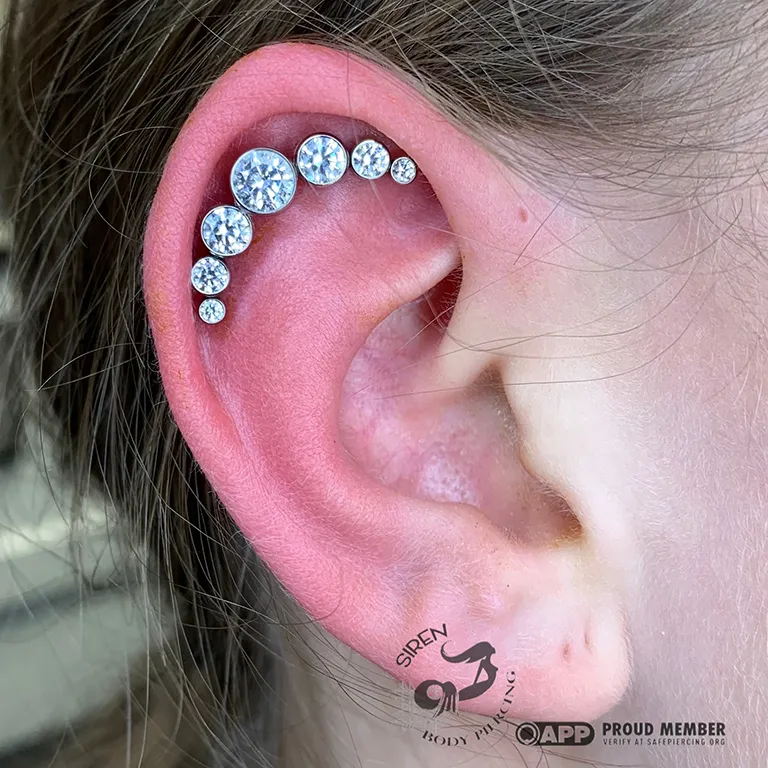siren
Body PiercingFine Jewelry and Body Piercing Studio
Caring For Your New Body Piercing
It is important to take proper care of your fresh piercing to ensure that it heals nicely and looks beautiful.
Use the guide below to review our piercing aftercare suggestions
What to expect with your new piercing
Some possible light bleeding, swelling, bruising, and discharge is a normal and part of your body’s natural response to receiving a wound. During healing, you will also notice itching, whitish discharge, crustiness, and tenderness. All of these are part of normal healing and will subside with time. Follow this link Piercing Healing Times to see average healing times for most basic piercngs.
DO’s & Dont’s
Below is a list of DO’s and DON’Ts to follow as your piercings heal. Of course, if you have any questions about any of these instructions please don’t hesitate to reach out. There are no “dumb questions” when it comes to your health and the happy healing of your new piercing. We are here for you, start to finish, and want nothing more than to see you with your piercing for years to come.
Don’t’s
- DON’T touch, spin, or play with your jewelry while the piercing is healing.
- Do your best NOT to snag your piercing on clothing or bump it on external objects.
- DO NOT SLEEP ON YOUR PIERCING. If you sleep on a healing piercing can cause it to migrate and become crooked, resulting in a very angry piercing. If you are a side sleeper with a new ear piercing, get yourself a travel pillow with a hole in the middle and place your head on that while you sleep. This will keep pressure off the piercing site.
- Do not use harsh chemicals such as alcohol, hydrogen peroxide, iodine, Neosporin ointment, soap, or tea tree oil on your healing piercing.
- Do not allow the piercing site to stay wet. After soaking dry piercing site thoroughly with a disposable paper towel or q-tip. Do not dry it with your bath towel. And do not go to bed with wet hair.
- DO NOT submerge your piercing in any body of water while it is healing. This includes bathtubs, lakes, oceans, hot tubs, swimming pools, rivers, etc. This water contains microorganisms and harmful bacteria that can cause an infection. For navel and nipple piercings, a waterproof bandage, such as Tegaderm, can be worn over the piercing for swimming.
- Do not change your jewelry before it is fully healed. Healing times will vary depending on the piercing site and from person to person. Your piercing may feel fully healed before it is. If you have questions about healing time, please reach out to us!
DO’s
- Soak your piercing once a day with a sterile saline solution and then Briotech Spray (if using) for about 20 min each. After a shower is best. A second soaking is ok if you engage in sports or a physical activity that can soil the piercing more than normal.
- After soaking your piercing or after showering, dry your piercing thoroughly with a single use, disposable implement such as a paper towel or q-tip.
- Let warm water run over the piercing in the shower daily.
- Try to keep soap, body washes, and other body products such as makeup and moisturizers away from the piercing site.
- If you are not actively cleaning or caring for your, leave the piercing and jewelry alone.

Specifics for Oral Piercings
If you use mouthwash switch to an alcohol-free brand. If you do not already use mouthwash, no need to start.
Oral hygiene is extremely important. Brush and floss twice a day. Use gentle, non-whitening toothpaste. If your jewelry builds up plaque you can brush it away with a wet toothbrush.
Drink water! Cold water will help with swelling as well as keep you hydrated so healing is easier.
Swish with cold water after eating, drinking, or smoking. This will help clear the piercing area of any food build-up and prevent irritation.
Do not play with or bite your jewelry.

Specifics for Genital Piercings
Genital piercings can bleed for the first few days. These areas have a lot of blood flow, and it is not uncommon for a fresh piercing to bleed freely, especially in the mornings for some male genital piercings.
Feel free to engage in sexual activity whenever you feel comfortable, but use barriers! Condoms and dental dams are important to avoid contact with your partner’s body fluids. If a fluid did not come from your body, it should not be in contact with your healing piercing Listen to your body. Avoid any rough play or unnecessary trauma to the piercing site.
After any sexual contact rinse with saline or clean warm water.

Downsizing
In most cases, initial jewelry will be long to accommodate for swelling. When the swelling subsides, your jewelry will be longer than necessary and inappropriate for long-term wear. It is important to visit your piercer to downsize to a properly fitted piece after the swelling has gone down. This will prevent unnecessary trauma to the piercing site and will be much more comfortable to wear.
Not downsizing in an appropriate timeframe may lead to irritation, bumps, and migration.
We DO recommend making an appointment for all jewelry downsizes.
Contact Us
The best way to schedule your piercing appointment is to give the shop a call directly at 603-279-3311. You are also welcome to fill out the form if you have any questions prior to making your appointment.
We do take walk-ins for piercings if our schedule allows for them, but we do HIGHLY RECOMMEND scheduling an appointment for all services. This includes new piercings, post-shortening, or jewelry swap-outs. As well as purchasing new jewelry whether you plan on having it installed at the studio or not.